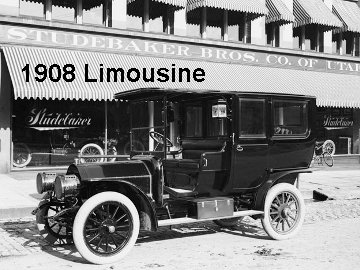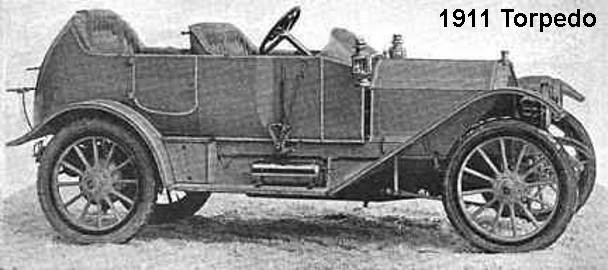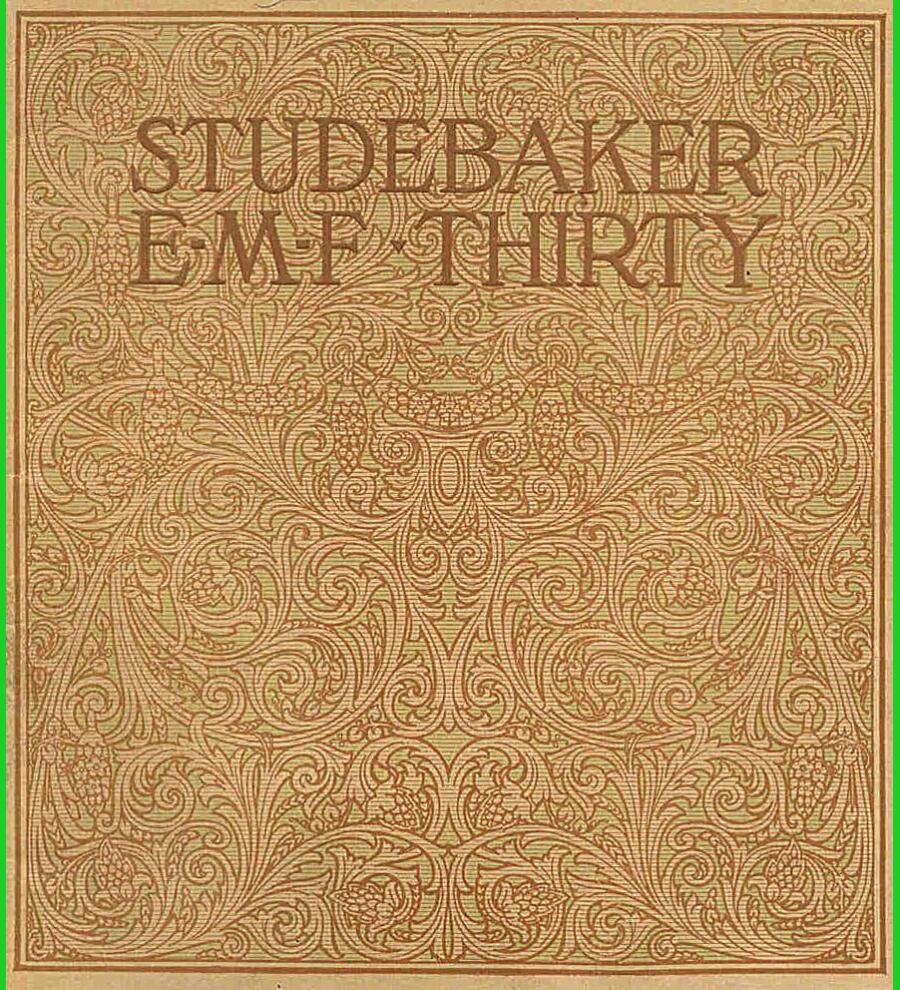Rock River Valley Chapter of the Studebaker Drivers Club
Our Charter, Keeping the Studebaker Marque Alive
|
 |
|
|
 |
|
|
|
|
The Early Days of Studebaker Automotive
Electric Car:
Studebaker entered into automobile manufacturing in 1898 when Fredrick Fish, Chairman of the executive committee, persuaded the board to supply $4,000 for the development of an electric car. However, without the board’s full support, the project yielded only one car. The company did, however, began producing bodies for electric taxis for Alexander Pope’ Electric Vehicle Company (EVC). EVC provided electric taxis, to compete with horse drawn taxis in many major cities through out the US. However, EVC was bankrupt by 1902.
Studebaker started production of it’s own Electric cars in 1902. Thomas Edison (so the story goes) purchased the second of twenty electric cars manufactured that first year of production.
First Electric Car:
Drive: Chain Drive - Steering: Tiller - Power: Westinghouse electric motor - Gears: Four forward speeds - Brakes: Duel - Speed: 3, 5, 9, and 13 mph - Range: 40 miles.
Starting in 1904, Electric cars were made available in a variety of body styles, which mimicked bodies Studebaker had produced for its passenger carriage line. These included Stanhope, Victoria, a four passenger model, and a light delivery. Max speed increased to 14 mph. In 1906 a four passenger coupe and a stake truck were added. From "Studebaker The Complete Story" written by William A. Cannon and Fred K. Fox, the initial models offered were 2 Runabouts, 1 Trap, and 2 Stanhopes. By 1910 production was down to a trickle, as focus had moved to gas car production. Studebaker manufactured 1841 electric car before production ended in 1912.
In 1904, Studebaker began production of gasoline powered car in partnership with Garford Company of Elyria, Ohio. Under the agreement, Garford would ship completed chassis and drive trains from Ohio and then Studebaker would mate them with Studebaker built bodies. They were sold under the Studebaker-Garford brand name. Eventually, even the Garford built engines would carry the Studebaker name. Garford also built a limited number of cars under its own name, and by 1907 attempted to increase their production at the expense of Studebaker. Once Studebaker discovered what was going on, Studebaker enforced their primacy clause, forcing Garford back onto the scheduled production quotas. In 1906 Garford, in order to fund it's expansion plan, had allowed Studebaker to become a minority investor, giving Studebaker three seats on the seven-member board, Garford expected to control the board with the remaining four seats. But Hayden Eames soon went over to the Studebaker side, giving Studebaker control of the board. Studebaker continued to aquire more shares and by 1908 Garford, was a minority stock holder in his own company. However by 1910, Studebaker was finding it impossible to attain the sales volume they wanted with Garford's limited manufacturing facilities and high prices. The decision to drop Studebaker-Garford was made and the final product rolled off of the assembly line by 1911 or 1912. Studebaker sold it's interest in Garford's company to Willy-Overland, in 1911 or 1912, leaving Garford to try it alone until finally Garford's shares were acquired by John North Willys in 1913.
Body Styles:
I found very little information on exactly what body styles were offered in what years. From Thomas Bonsall's "The Studebaker Story", we find the first car (1904) was a touring car with removable tonneau. Several sources on the internet indicate; that when tonneau was removed; this then became the two passanger runabout. Bonsall, further states for model year 1905 a touring car was added to the model "C"; renamed the 9502 line-up; thus one could conclude this was in addition to the existing runabout which had lost it's removable tonneau. The model 9503, a longer wheel base, four cyl. model was also added, but Bonsall does not mention what body styles were offered in this range; however one could guess the two passenger runabout and a touring car. For 1906 the model 9503 was carried over as the new year model E; along with two totally new models; F & G, adding additional wheel base and horse power options. No mention of body styles is offered. Bonsell, indicates the 1906 models were carried over to 1907 as the model L, G, and H respectively with little change and still no mention of body styles. In 1908 the model "B" is added, a 40 HP, 114 inch wheel base model, but as before, no body styles are mentioned. Bonsall does not cover the Garford, after the 1908 model year.
I found the following information in a book written by William A. Cannon and Fred K. Fox "Studebaker The Complete Story". Some of the information seems to conflict with Bonsall's version, so is offered as and alternate possibility. This book indicates the first Garford model was a Rear entrance Tonneau which sold for $1,600 dollars and was offered with a optional Canopy top for an additional $150 dollars. In 1905 a side entrance Tonneau was offered. In 1910 the Model G-7 was offered in Limousine, Touring, Tourabout, and Speedster. This seem to agree with the color catalog discussed below. Cannon and Fox set total Studebaker-Garford production at 2,481 units over seven years.
Additional research on the internet turns up an eBay ad for an original color catalog , 5 x 8 , 22 pages . It includes models G7 , 30 , and 40 . Shows five models including Speed Car , Tourabout , Landaulet , Limo , and Touring. I found another 1908 Studebaker ad for the Model "B" fourty, which listed body styles of Limo, Landaulet, Town Car, Touring, Roadster, and Torpedo. Also several photo's of cars can be found as shown below.
 
|
Year |
Model |
Series |
CYL |
HP |
WB |
Cost |
Production |
|
1904 |
C or 202 |
Garford |
2 |
16 |
82 |
$1,600 |
20 |
|
1905 |
9502 |
Garford |
4 |
16 |
82 |
$1,250 |
Unknown |
|
1905 |
9503 |
Garford |
4 |
20 |
96 |
$3,000 |
Unknown |
|
1906 |
E |
Garford |
4 |
20 |
96 |
$2,600 |
Unknown |
|
1906 |
F |
Garford |
4 |
28 |
104 |
$3,000 |
Unknown |
|
1906 |
G |
Garford |
4 |
30 |
104 |
$3,700 |
Unknown |
|
1907 |
L |
Garford |
4 |
20 |
96 |
Unknown |
Unknown |
|
1907 |
G |
Garford |
4 |
28 |
104 |
Unknown |
Unknown |
|
1907 |
H |
Garford |
4 |
30 |
104 |
Unknown |
Unknown |
|
1908 |
A |
Garford |
4 |
Unknown |
Unknown |
Unknown |
Unknown |
|
1908 |
H |
Garford |
4 |
Unknown |
Unknown |
Unknown |
Unknown |
|
1908 |
B (Fourty) |
Garford |
4 |
40 |
114 |
Unknown |
Unknown |
|
1909 |
A |
Garford |
4 |
Unknown |
Unknown |
Unknown |
Unknown |
|
1909 |
B |
Garford |
4 |
Unknown |
Unknown |
Unknown |
Unknown |
|
1909 |
C |
Garford |
4 |
Unknown |
Unknown |
Unknown |
Unknown |
|
1909 |
D |
Garford |
4 |
Unknown |
Unknown |
Unknown |
Unknown |
|
1910 |
H |
Garford |
4 |
Unknown |
Unknown |
Unknown |
Unknown |
|
1910 |
G7 |
Garford |
4 |
Unknown |
Unknown |
Unknown |
Unknown |
|
1911 |
G840 |
Garford |
4 |
Unknown |
Unknown |
Unknown |
Unknown |
|
1911 |
G10 |
Garford |
4 |
Unknown |
Unknown |
Unknown |
Unknown |
Model information 1908 A&H, 1909 A,B,C,&D, 1910 H, and 1911 G840&G10 are unverified Sourse for this information is www.jasonheckman.com
1909 Ad for the Studebaker-Garford G7 "Fourty". Note the four digit phone numbers at the bottom.
1910 Ad for the Studebaker-Garford G7 "Fourty". Note the applications for unallotted territories.
In 1908, Studebaker enters into a sales agreement with the Everett - Metzger - Flanders Company (E-M-F), incorporated in Detroit Michigan. Studebaker's marketing agreement with E-M-F was a different relationship then that with Garford, one Studebaker had hoped would give it a quality product, without the entanglements found in the Garford relationship. Unfortunately, this was not to be the case.
Under the terms of the agreement, E-M-F would manufacture vehicles and the Studebakers would distribute them through their wagon dealers. Problems with E-M-F made the cars unreliable leading the public to say that E-M-F stood for "Every Morning Fix-it". Studebaker, unhappy with E-M-F's poor quality, gained control of E-M-F assets and plant facilities in 1910. To remedy the damage done by E-M-F, Studebaker paid mechanics to visit each unsatisfied owner and replace the defective parts in their vehicles at a cost to the company of one million US dollars.
In 1911 the company reorganized as the Studebaker Corporation. In 1913, the E-M-F name was replaced with Studebaker on all new automobiles produced at the former E-M-F facilities, both as an assurance that the vehicles were well-built, and as it's commitment to making automobile production and sales a success.
E-M-F/Studebaker Time Line:
Source: "The Studebaker Story" Thomas E. Bonsall
Most of the data below comes from the current EMF website. http://emfauto.org/index.php
|
Year |
Model |
Series |
Line-Up |
CYL |
HP |
WB |
Price / Production |
|
1909 |
30 |
EMF |
Touring, Demi-Tonneau, Roadster Single or Double, and Runabout |
4 |
30 |
106 |
$1,400 / 7,960 |
|
1910 |
30 |
EMF |
Touring, Demi-Tonneau, Roadster |
4 |
30 |
108 |
$1,250 / 9,417* |
|
1911 |
A30 |
EMF |
Touring, Demi-Tonneau, Open Touring, Roadster, and Coupe |
4 |
30 |
108 |
$1,100 / 17,194* |
|
1912 |
A30 |
EMF |
Touring, demi-Tonneau, Roadster, and Coupe |
4 |
30 |
112 |
$1,100 / 13,048* |
|
|
|
|
|
|
|
|
|
|
1910 |
20 |
Flanders |
Runabout and Touring |
4 |
21 |
100 |
$750,$790 / 5,603* |
|
1911 |
S20 |
Flanders |
Runabout, Suburban, Roadster |
4 |
21 |
100 |
$700,$725,$925 / 9,633* |
|
1912 |
S20 |
Flanders |
Runabout, Touring, Suburban, Roadster, and Closed Coupe |
4 |
21 |
100 |
$775,$800,$800$750,$1,000 / 14,562* |
Production Number for EMF and Flanders *Source: New York-Herald-Tribune
|
Model |
1909 |
1910 |
1911 |
1912 |
1913 |
|
EMF-30 |
7,960 |
9,417 |
17,194 |
13,048 |
|
|
Flanders 20 |
|
5,603 |
9,633 |
14,562 |
909 |
|
Totals |
7.960 |
15,020 |
26,827 |
27,610 |
909 |
These production totals agree with the emfauto.org site except for 1912 were their number is 27,827. No breakdown between EMF-30's and Flanders 20's is given. The 909 number for 1913 is also not shown on the emfauto site.
Studebaker Early Racing:
In these early years 1909, 1910, and 1911 there were famous races called the "The Great Savanna Races". The race for the light cars division was called "The Tiedeman Trophy Race". Here are the results from 1910 and 1911.
The Tiedeman Trophy
1910 and 1911, sponsored by Mayor George Tiedeman of Savannah, Georgia.
1910:
This race was first run as the small car division of the International Light Car race, along with the Savannah Challenge Trophy. The first winner of the race was Billy Knipper, second place was Frank Witt in an E.M.F 30 and Costello driving a Maxwell placed third. Fourth and Fifth place were also secured by Maxwell drivers, Wright and Doorley. Knipper drove a Lancia and had an average speed of 58.44 mph, driving a total distance of 190.3 miles. Knipper’s fastest time was 17.3 miles in 17 minutes and 20 seconds. The victor won a prize of $1000.00 Drivers Cohen, Endicott and Knight did not finish due to mechanical failures.
1911:
This race was November 27, 1911 and was 10 laps on a 17.14 mile course. The drivers competing were Witt, Evans and Tower in an E.M.F. 30, Kulick in a Ford, Roberts and Hartman in Abbott-Detroits. Witt won the race with a time of 171.40 in 2 hours, 56 minutes, 23.34 seconds. His average speed was 58.10 mph. Evans placed second, with Tower in third and Kulick in fourth. Roberts and Hartman did not finish their Abbott-Detroits due to mechanical failures.
As a result of the sweep in 1911, the first three places, Studebaker created a "SALES BROCHURE" See Below

The End |
|
|
|
|
|
|
|
 |
|